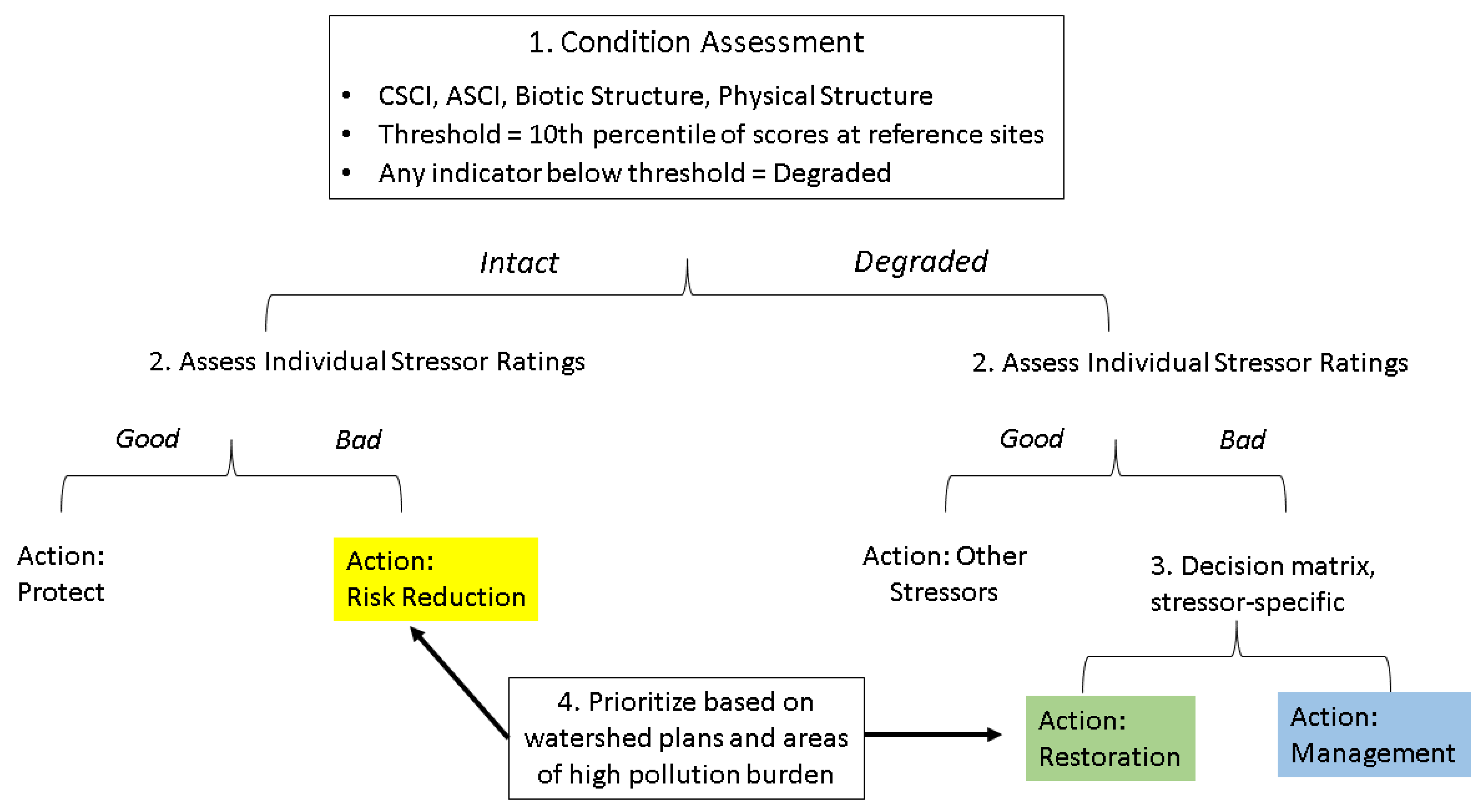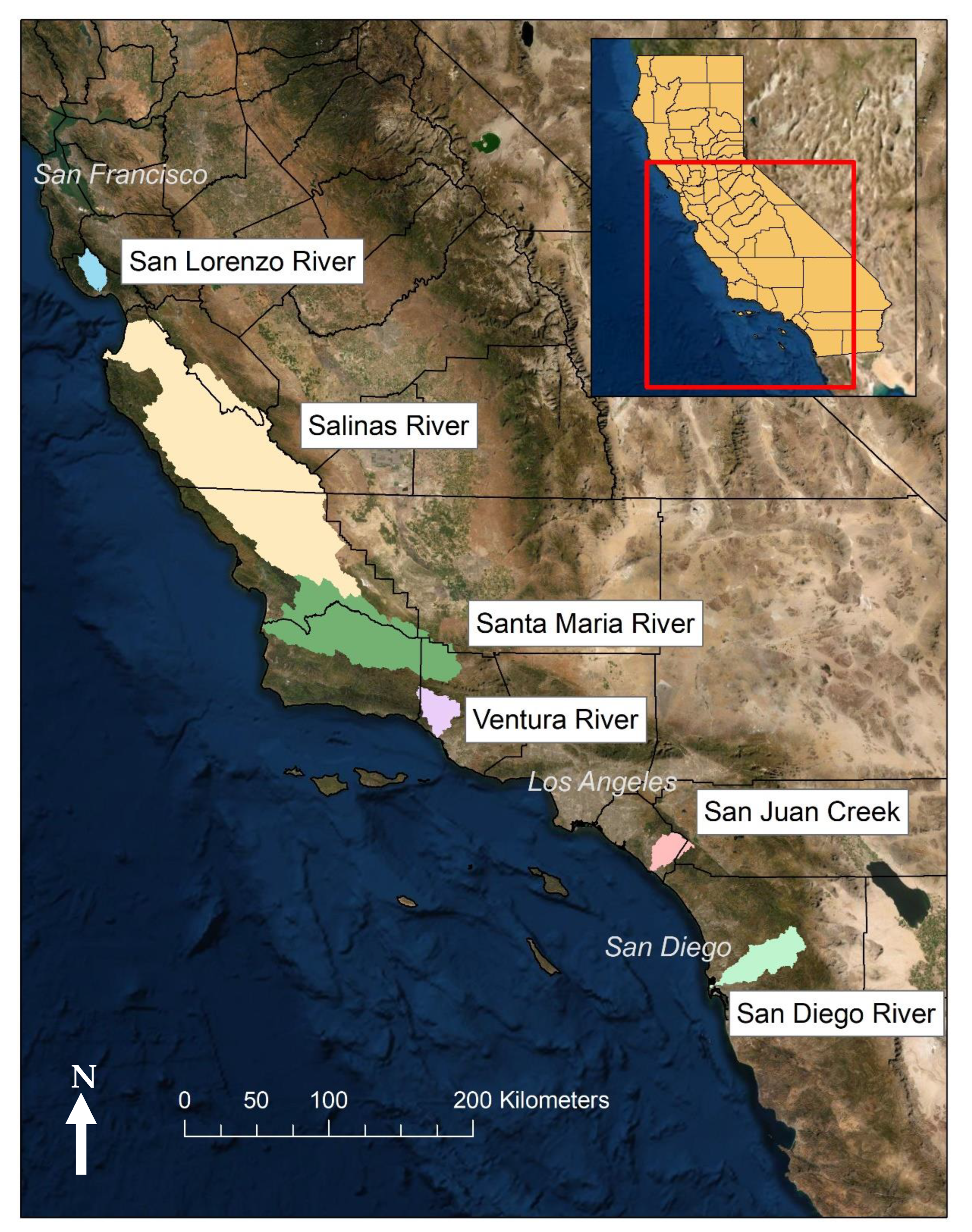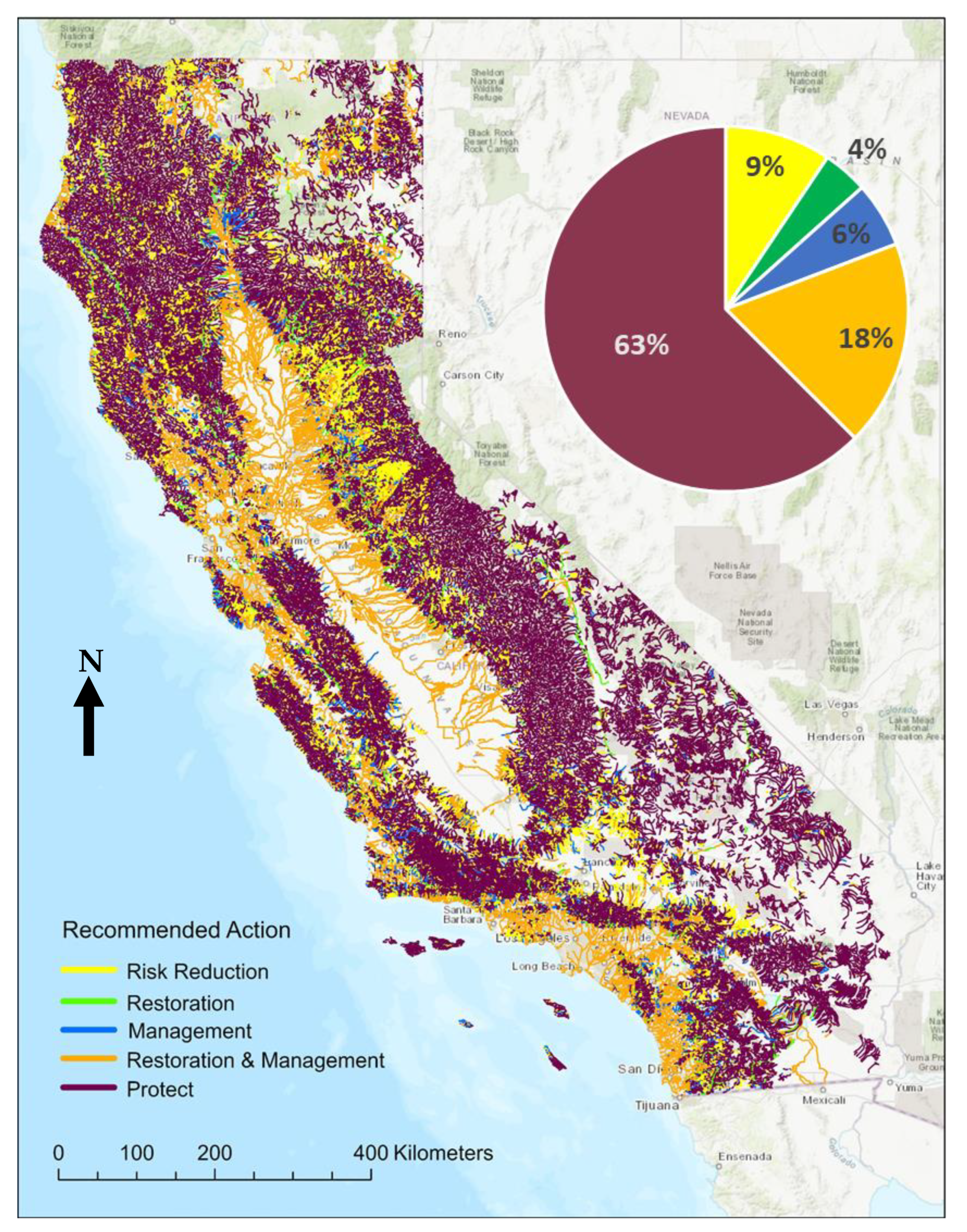4.1. Utility of Tools for Watershed Prioritization
In this study, we developed a broadly applicable tool that can aid watershed managers in prioritizing protection, restoration, and management actions at a watershed scale to help promote overall watershed health. The prioritization tool leverages readily available data sources, such as statewide stream condition data based on ambient monitoring programs and USEPA’s national StreamCat database. As such, the tool can be easily applied to watersheds across diverse settings and landscapes using basic datasets that are available nationwide, such as USEPA’s National Rivers and Streams Assessment [
28].
Developing this prioritization tool overcomes several traditional impediments to comprehensive watershed planning. First, results are provided at the reach scale, providing a more direct relationship with management actions. Other watershed prioritization tools use algorithms to provide results at the catchment scale (e.g., HUC 12), which requires assumptions or interpolation of management actions to specific locations [
29,
30]. In contrast, output at the reach scale allows managers to target their actions more easily to specific locations. Second, the tool provides specific recommendations tied to the most predominant stressors directly affecting biological condition at each stream location. Moving beyond general recommendations such as “management” or narrow outcomes such as “prioritization for non-point source control” [
31] to a broader set of suggestions that remedy specific stressors helps support more directed and holistic watershed planning. This also increases the likelihood that stress amelioration will result in improvement of biological communities. Third, the tool is automated and can be easily applied to any watershed. This provides for rapid production of initial planning-level maps that can guide additional monitoring and subsequent in-depth analysis. This would be particularly useful for under-sampled areas where site-specific condition or stress data are not readily available. Because watershed planning can be an intensive process that involves data mining, compilation, synthesis, and manual analysis, the time and cost necessary to complete this process can often deter local watershed managers from attempting such comprehensive analysis, particularly in areas where resources or data are limited [
30]. The availability of broadly applicable tool may lower these initial barriers to watershed planning. The tool can also supplement analysis in areas where local observations and field data are available by serving as an initial screening tool that can be verified with local data and by helping to provide information where field observations are not available. For example, the tool can be used to prioritize areas where formal causal assessment analysis should be conducted [
32].
Parsimony in model development was based on a relatively sparse structure for the random forest modeling and a simple rule-based model for the management prioritization analysis. A sparse model structure contains the smallest number of covariates that might explain the greatest amount of variance in the dependent variable. Because this approach poses opportunities to inform decision-making, data collection, and protection and restoration activities in resource-restricted areas, it can be applied in a variety of settings regardless of the availability of local data. We recognize that streams and rivers are diverse systems with complex relationships to their biological communities and their surrounding societies, but our approach aims to balance this inherent complexity with a level of sparsity that best supports prioritization of management actions. The indices used in the random forest model development, ASCI, CSCI, and CRAM, are already examples of this balance of sparsity and complexity, combining several raw measures of biotic and physical conditions into a single metric [
14,
15,
16]. By collapsing the axes of variability, this approach was designed to reduce the relative importance of variability in any one raw measure and enable trends in state-wide index datasets to emerge more clearly. For example, CRAM provided lower levels of discrimination because it is less sensitive to catchment-scale predictors, yet it provides a more direct estimation of habitat quality. These dichotomies can be offset by combining multiple condition indices. In the series of random forest models developed, we identified multiple shared environmental variables affecting stream condition, namely impervious and urban land cover as well as road density and crossings with streams which allows maximum leverage from limited data and improves overall relationships between stress and condition.
Results of random forest model development for condition assessment underscored the importance of long-term monitoring data in a variety of stream environments. Regions that had more data provided more information on which to develop the model and, as a result, their models explained a greater proportion of the variability in the data (
Figures S2, S4, S6 and S8). Others have also called for increased monitoring as a critical need for future restoration efforts [
33], and our model validation efforts highlighted the value of additional data, particularly in traditionally under-sampled regions. Similarly, monitoring the effect of future management actions on stream condition can provide the opportunity to verify the outputs of the prioritization tool and further refine it over time.
Tool acceptability was further enhanced through inclusive development of the rule-based model used to determine thresholds and match stressors with management actions. All rules and relationships in the models were co-developed and vetted through a statewide technical workgroup that included agency representatives and practitioners. This workgroup agreed on the approach to establishing thresholds, assigning stressors to mutually exclusive management categories and identifying specific actions to remedy specific stressors. Past studies have shown that agreement among experts on rule-based models can be considered equally reliable as models parameterized with empirical observations and results in higher reliability than subjective or “black-box” approaches [
34,
35]. Moreover, ensuring transparency in the development process, including important caveats and limitations of the tool improves confidence in the outcomes and helps achieve consensus on the appropriateness, logic, and defensibility of the products. Finally, the technical workgroup agreed that the recommendations provided by the tool should serve as suggestions to be further evaluated through site-specific analysis.
Reliance on StreamCat for stressor analysis provides a way to easily apply this approach nationwide using readily available data that are routinely updated. However, StreamCat is limited in that it only considers certain stressors and neglects potentially important stressors, such as grazing, timber harvest, some types of mines, and groundwater extraction. For example, groundwater extraction can severely impact riparian zone and can lead to catastrophic bank erosion and complete alteration of the stream course [
36]. Such effects can be exacerbated by extended drought. Habitat descriptors based on conditions prevailing under years of non-extreme conditions may not be sensitive to severe drought, or effectively point toward the likely management needs associated with the disproportionate impacts under such conditions. StreamCat also under-represents the effects of aggregate extraction that can substantially alters stream structure. For example, historic aggregate mining in several of our pilot watersheds has been a major contributing factor to tens of meters of stream incision and water table decline, which has further affected stream conditions [
37]. Finally, effects of episodic disturbance that can profoundly affects stream condition, such as wildfires and floods, are not represented in StreamCat.
Because the analysis was designed to apply at a state scale and relies on readily available geospatial data layers, it does not account for finer scale, more localized factors, such as local passage barriers or floodplain encroachment. Once the initial screening analysis using this approach is completed, it is important for users to account for finer-scale stress data before making final management decisions. This data may be available from datasets not represented in StreamCat, but from other regional or local sources.
General patterns of recommended action statewide and in the six pilot watersheds corresponded to intensity of land uses in predictable ways. Moreover, tool performance was relatively consistent across the pilot watersheds, suggesting that it should be broadly applicable to all watersheds in the state. The exception was in the North Coast, where correlations were lowest. As noted, this may be due to sparser data. It may also reflect that these riparian systems are affected by variables other those tabulated by the five sets of standardized data, such as the influences of gorges on stream condition, the role of large wood logjams and the lingering effects of timber harvesting. In general, sites most in need of restoration and management were typically lower in the watershed where urban development is concentrated, or in the case of the Salinas River watershed, were associated with agricultural areas. High-quality sites recommended for protection were often at the interface between open space and urban or agricultural areas and were vulnerable due to elevated stressor levels. In contrast, sites recommended for no immediate action beyond continued protection were in more remote, less developed portions of the watershed. These sites should be monitored to determine if stress levels increase to a point where additional protective measures are recommended or if condition degrades to a level where restoration or management might be warranted. This is particularly important in consideration of globally induced changes in temperature, precipitation patterns and fire frequency which will have greater proportional effect on streams located in higher elevation, more natural portions of watersheds.
Most stream reaches in the state (63%) were in the protection category, suggesting that the prioritization tool was able to successfully identify reaches in greatest need of management intervention. However, it is important to keep in mind that all stream reaches are likely are already being affected by shifts in temperature and rainfall patterns associated with climate change. Moreover, future land use and resource management changes may pose additional threats. Therefore, every site has some degree of vulnerability and should be monitored for degradation from climate change, land use and resource management changes or a combination. Existing statewide monitoring programs could be used to periodically re-evaluate these “high quality” sites to determine their level of risk and whether their condition is declining.
Unlike other prioritization tools, the results of this analysis also provide recommendations for specific actions to help remedy specific stressors (e.g., culvert retrofit in reaches with high density of road crossings). Observations during ground-truthing generally corroborated recommendations provided by the prioritization tool, suggesting that it can be broadly applied across watersheds in an automated manner to support initial watershed planning efforts. Coordination with local watershed plans could allow for additional prioritization through weighting of stressors based local priorities or ease of management intervention and provide opportunities s for leveraging of effort and investment to achieve multiple objectives associated with improving watershed health. Additional prioritization measures could also be imposed for lower stream reaches near the coast whose condition may be influenced by mouth conditions where they drain into the ocean. Closing patterns, and changes to those patterns due to armoring, artificial breaching, changing freshwater flows, and sea level rise can all affect condition in ways that are not detected through our analysis. These areas may also have additional environmental justice or community concerns that could affect how they are prioritized for management.
4.2. Importance of Accounting for Potentially Affected Communities
Regardless of model transparency, analytical results alone cannot always produce reliable restoration decisions [
38]. Decisions need to include consideration of stakeholder values and community interests and needs. These communities are often closely related to their local rivers and streams, and they will have different priorities and values based on both cognitive and emotional perspectives. Many areas may have religious or cultural significance for indigenous cultures that should be integrated into watershed planning. In general, restoration efforts have a propensity to prioritize restoration in natural areas because they are easier to regain ecological functions. However, this narrow ecological and engineering focus contributes to the exclusion of restoration in areas that can provide benefits to communities that often lack access to “natural areas” for recreational and educational benefits [
39].
Research in environmental justice has repeatedly noted that scientific information by itself is not sufficient to indicate the ideal location for projects. Rather, a full consideration of the expected benefits, and where they accrue, is also important. This can best be accomplished by expanding restoration considerations beyond the stream itself to the characteristics and needs of the surrounding communities. In this study, we attempted to include environmental justice considerations into restoration prioritization using the CalEnviroScreen dataset. CalEnviroScreen data supplies California communities with environmental, health, and socioeconomic data pertaining to each census tract, allowing the community to examine which regions have the highest levels of pollution and population burdens. Our preliminary analysis showed little correlation between the CalEnviroScreen indicators and indicators of stream condition (e.g., ASCI, CSCI, and CRAM). At one level, this suggests that the two assessments are measuring different things (stream condition vs. condition of the surrounding community). At another level, this suggests a potential incongruence between ecological and social needs. By prioritizing streams in areas with the highest overall pollution burdens, we can begin to better incorporate the needs of under-resourced communities into the restoration prioritization process. Full integration of ecological and social issues will ultimately require development of new indicators that more directly measure ecological aspects of streams that provide social benefit, such as access to recreational opportunities. Consideration of the broader social benefits of restoration and management was beyond the scope of this study but is an important area for future investigation.















